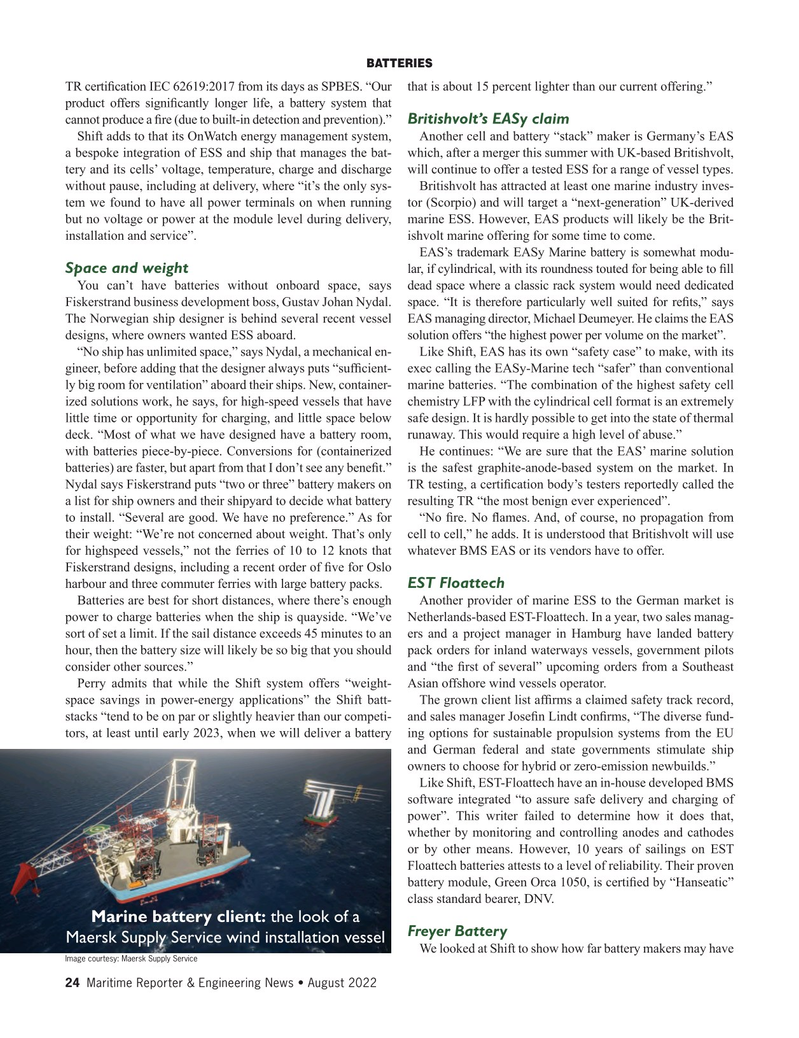
Page 24: of Maritime Reporter Magazine (August 2022)
The Shipyard Annual
Read this page in Pdf, Flash or Html5 edition of August 2022 Maritime Reporter Magazine
BATTERIES
TR certi? cation IEC 62619:2017 from its days as SPBES. “Our that is about 15 percent lighter than our current offering.” product offers signi? cantly longer life, a battery system that cannot produce a ? re (due to built-in detection and prevention).” Britishvolt’s EASy claim
Shift adds to that its OnWatch energy management system, Another cell and battery “stack” maker is Germany’s EAS a bespoke integration of ESS and ship that manages the bat- which, after a merger this summer with UK-based Britishvolt, tery and its cells’ voltage, temperature, charge and discharge will continue to offer a tested ESS for a range of vessel types.
without pause, including at delivery, where “it’s the only sys- Britishvolt has attracted at least one marine industry inves- tem we found to have all power terminals on when running tor (Scorpio) and will target a “next-generation” UK-derived but no voltage or power at the module level during delivery, marine ESS. However, EAS products will likely be the Brit- installation and service”. ishvolt marine offering for some time to come.
EAS’s trademark EASy Marine battery is somewhat modu-
Space and weight lar, if cylindrical, with its roundness touted for being able to ? ll
You can’t have batteries without onboard space, says dead space where a classic rack system would need dedicated
Fiskerstrand business development boss, Gustav Johan Nydal. space. “It is therefore particularly well suited for re? ts,” says
The Norwegian ship designer is behind several recent vessel EAS managing director, Michael Deumeyer. He claims the EAS designs, where owners wanted ESS aboard. solution offers “the highest power per volume on the market”.
“No ship has unlimited space,” says Nydal, a mechanical en- Like Shift, EAS has its own “safety case” to make, with its gineer, before adding that the designer always puts “suf? cient- exec calling the EASy-Marine tech “safer” than conventional ly big room for ventilation” aboard their ships. New, container- marine batteries. “The combination of the highest safety cell ized solutions work, he says, for high-speed vessels that have chemistry LFP with the cylindrical cell format is an extremely little time or opportunity for charging, and little space below safe design. It is hardly possible to get into the state of thermal deck. “Most of what we have designed have a battery room, runaway. This would require a high level of abuse.” with batteries piece-by-piece. Conversions for (containerized He continues: “We are sure that the EAS’ marine solution batteries) are faster, but apart from that I don’t see any bene? t.” is the safest graphite-anode-based system on the market. In
Nydal says Fiskerstrand puts “two or three” battery makers on TR testing, a certi? cation body’s testers reportedly called the a list for ship owners and their shipyard to decide what battery resulting TR “the most benign ever experienced”. to install. “Several are good. We have no preference.” As for “No ? re. No ? ames. And, of course, no propagation from their weight: “We’re not concerned about weight. That’s only cell to cell,” he adds. It is understood that Britishvolt will use for highspeed vessels,” not the ferries of 10 to 12 knots that whatever BMS EAS or its vendors have to offer.
Fiskerstrand designs, including a recent order of ? ve for Oslo harbour and three commuter ferries with large battery packs. EST Floattech
Batteries are best for short distances, where there’s enough Another provider of marine ESS to the German market is power to charge batteries when the ship is quayside. “We’ve Netherlands-based EST-Floattech. In a year, two sales manag- sort of set a limit. If the sail distance exceeds 45 minutes to an ers and a project manager in Hamburg have landed battery hour, then the battery size will likely be so big that you should pack orders for inland waterways vessels, government pilots consider other sources.” and “the ? rst of several” upcoming orders from a Southeast
Perry admits that while the Shift system offers “weight- Asian offshore wind vessels operator. space savings in power-energy applications” the Shift batt- The grown client list af? rms a claimed safety track record, stacks “tend to be on par or slightly heavier than our competi- and sales manager Jose? n Lindt con? rms, “The diverse fund- tors, at least until early 2023, when we will deliver a battery ing options for sustainable propulsion systems from the EU and German federal and state governments stimulate ship owners to choose for hybrid or zero-emission newbuilds.”
Like Shift, EST-Floattech have an in-house developed BMS software integrated “to assure safe delivery and charging of power”. This writer failed to determine how it does that, whether by monitoring and controlling anodes and cathodes or by other means. However, 10 years of sailings on EST
Floattech batteries attests to a level of reliability. Their proven battery module, Green Orca 1050, is certi? ed by “Hanseatic” class standard bearer, DNV.
Marine battery client: the look of a
Freyer Battery
Maersk Supply Service wind installation vessel
We looked at Shift to show how far battery makers may have
Image courtesy: Maersk Supply Service 24 Maritime Reporter & Engineering News • August 2022
MR #8 (18-33).indd 24 8/1/2022 10:20:29 AM

 23
23

 25
25
